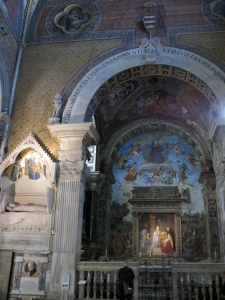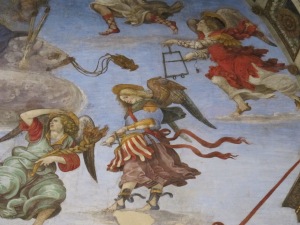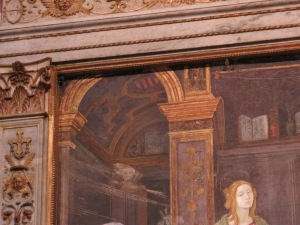A lazy stone’s throw from the Pantheon, the church of Santa Maria sopra Minerva takes its name from its position above an ancient temple dedicated to Minerva. It’s my absolute favourite short cut in Rome, enter on Piazza della Minerva and leave by the back door on the tiny Via Beato Angelico and in a moment be whisked from the hustle of the street into a silent gloom pungent with centuries of incense and polish. As you wander through, take a look at the Carafa Chapel at the head of the right transept, one of the most exquisite artistic projects of early Renaissance Rome. Maximum cost: 1 euro to switch on the lights in the chapel. What more could you possibly require from a short cut?
Commissioned from Filippino Lippi by the Neapolitan Cardinal Oliviero Carafa, it is dedicated to the Virgin of the Annunciation and to Saint Thomas Aquinas, a distant ancestor of the cardinal, a fact attested to by the the solidly classical letters of the inscription of the entrance arch. In the centre of the arch we can see the crest of Oliviero’s family, red and white horizontal stripes topped with his cardinal’s hat.
His was a precocious and dazzling career; in 1458, at the age of 28, he had been appointed Archbishop of Naples, and within ten years would be created a cardinal. The defining moment of his prodigious progress came in 1472 when he was appointed commander of the papal fleet of Sixtus IV and triumphed over the Turks at Smyrna (modern-day Izmir) in Western Turkey, twenty years after Constantinople had fallen.
By his late 50s Oliviero’s thoughts turned to his funerary chapel, and in the late summer of 1488 he was introduced, by Lorenzo de’ Medici, to Filippino Lippi. Then aged about 30, Filippino was contracted to paint Carafa’s family chapel. Work appears to have been completed by 25th March 1493, when Pope Alexander VI is recorded as having visited the chapel to celebrate the Mass of the Feast of the Annunciation.
Oliviero’s choice of a Florentine artist, and that this choice be taken upon the recommendation of the Medici, was fitting for a man intent on reconciling Rome and Florence. Oliviero’s career had taken flight under the previous Pope, Sixtus IV, who had been at war with the Medici. Despite a mutually beneficial peace accord in 1481 a certain rancour still lingered. However one cannot see the choice of artist in purely political terms; Oliviero must also have been only too aware that to follow the artistic advice of the Medici was to be at the cutting edge of contemporary taste.
My favourite part of the chapel is the altar wall, a sort of altarpiece within an altarpiece. The upper part of the wall shows the Virgin assumed into heaven, shown standing on a cloud supported by angels, while other angels play musical instruments.
To the left and right at the bottom of the painting, assorted apostles gaze in astonishment at the empty tomb. Or rather we can assume that they do, because in fact we don’t see it.
Instead, apparently “hanging” over the place where the tomb should be is the framed painting of the Annunciation. Apparently set in Oliviero Carafa’s study, we are presented with a curious, and somewhat socially awkward, scene. For while the angel appears to the Virgin, announcing the imminent birth of Christ, a deathly pale St Thomas Aquinas in the black robes of a Domenican is trying to introduce her to the kneeling Oliviero. I always wonder if perhaps he might have chosen a better moment.
Oliviero appears to be gazing, in some surprise, directly at the ghostly dove of the Holy Spirit above the Angel Gabriel who bears the lily of the Annunciation. The dynamic rays of light on which the Holy Spirit enters the room emphasises the angel’s movement, reinforced by the position of his feet; his right foot is springing forward, his left in the moment of coming down on the raised step. Though damage to the painting doesn’t allow us to be sure, it appears that this is the same floor level on which Oliviero is kneeling. The angel and the dove are beautifully framed by the arch which opens a barrel vault. The oblique view of the Carafa crest in the centre of the vault serves to emphasise the domestic nature of the setting.
At the top left and right hand corners of the inset altarpiece, and despite damage to the frescoes, ribbons are visible. These are anchored around the feet of the putti sitting on top of the trompe l’oeil pilasters which frame the scene. Whilst the left hand putto is very damaged, the one on the right is shown twisting to support Oliviero’s coat of arms whilst keeping the ribbon wrapped around his leg.
Although the damage means the bottom of the ribbon has been lost, it appears to be tied to a rail from which a curtain hangs which other putti seek to disentangle.
The originality of Filippino’s cycle lies in its integration of architectural and of sculptural elements within an overall illusionistic perspective space. Thanks to the methods of perspective, as first demonstrated in Florence by Filippo Brunelleschi and codified by Leon Battista Alberti in his De Re Aedificatoria of 1435, he was able to conceive of the space as a vast canopy in which the actual and pictorial architecture are as “real” as one another, and vital in the framing of the scenes represented.
All photographs are my own
The Carafa Chapel can be visited on my “Field of Mars” itinerary
Carafa Chapel,
Santa Maria sopra Minerva,
Piazza della Minerva









Nice post. It’s nice to find a site that finds the smaller treasures that are so easily overshadowed by the “greatest hits”.
Thanks!
This is very interesting